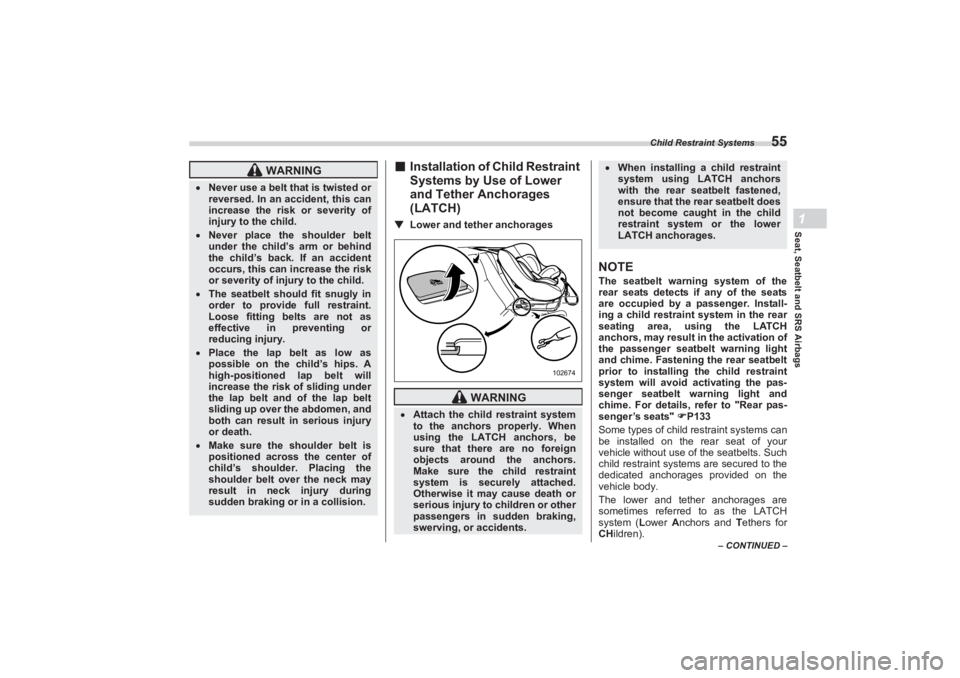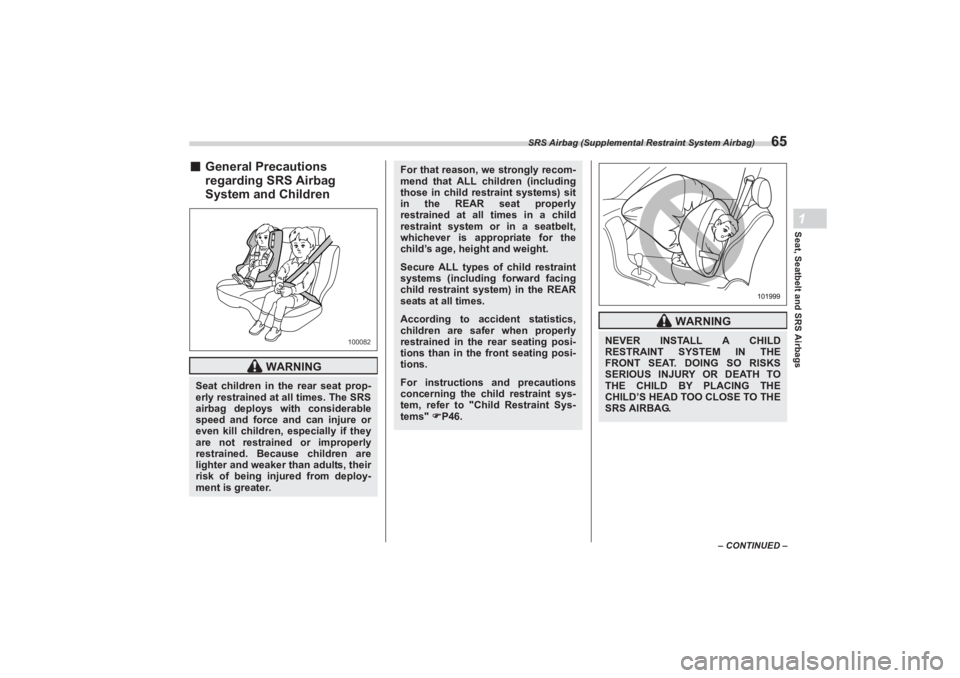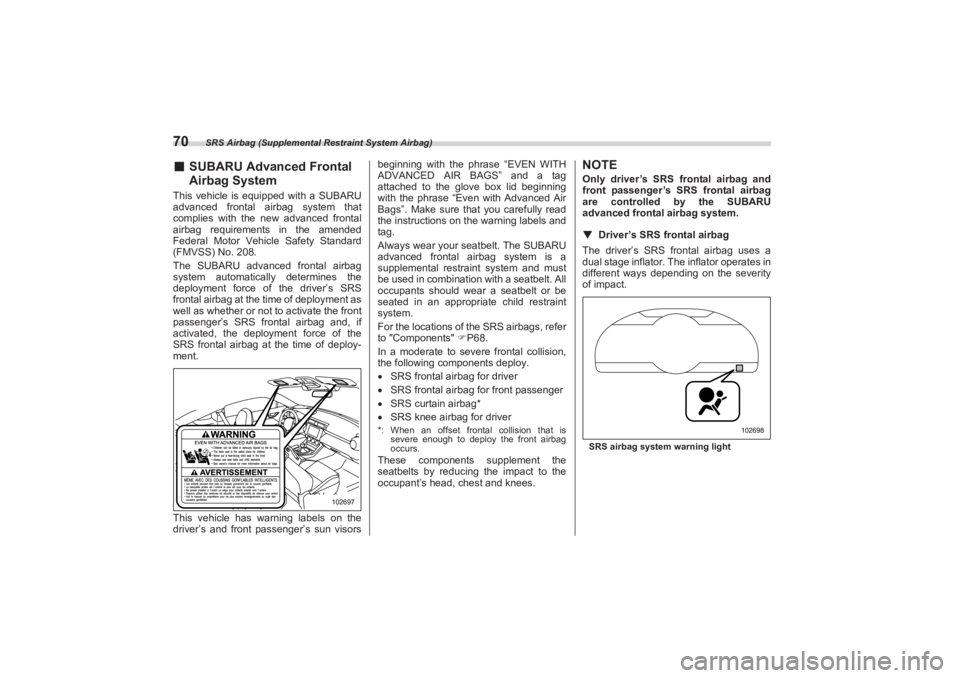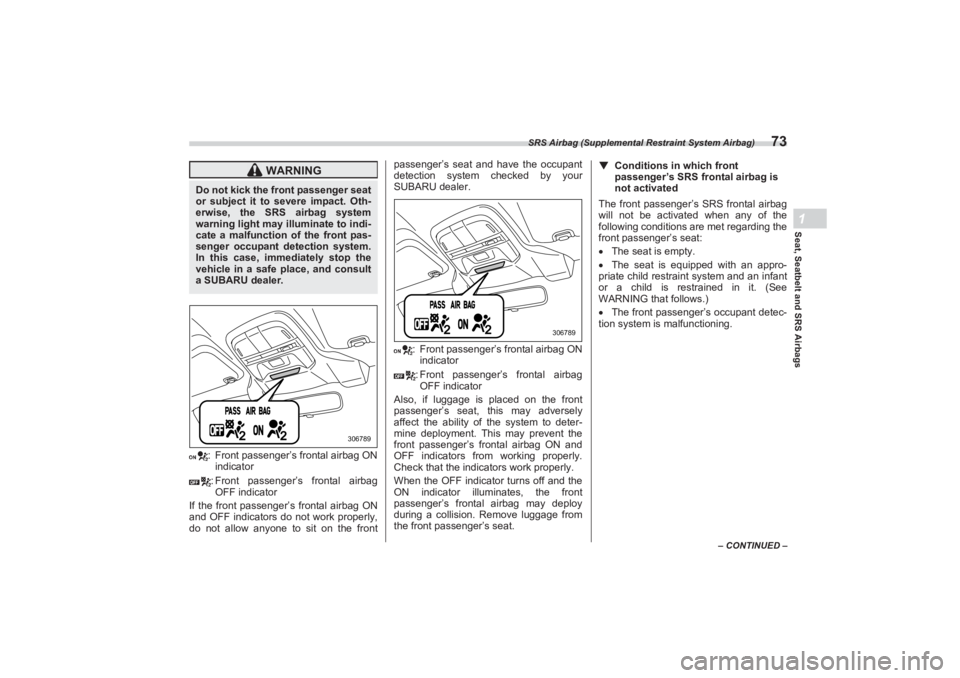2023 SUBARU BRZ light
[x] Cancel search: lightPage 61 of 432

Child Restraint Systems
55
Seat, Seatbelt and SRS Airbags1
– CONTINUED –
■Installation of Child Restraint
Systems by Use of Lower
and Tether Anchorages
(LATCH)▼ Lower and tether anchorages
NOTEThe seatbelt warning system of the
rear seats detects if any of the seats
are occupied by a passenger. Install-
ing a child restraint system in the rear
seating area, using the LATCH
anchors, may result in the activation of
the passenger seatbelt warning light
and chime. Fastening the rear seatbelt
prior to installing the child restraint
system will avoid activating the pas-
senger seatbelt warning light and
chime. For details, refer to "Rear pas-
senger’s seats" P133
Some types of child restraint systems can
be installed on the rear seat of your
vehicle without use of the seatbelts. Such
child restraint systems are secured to the
dedicated anchorages provided on the
vehicle body.
The lower and tether anchorages are
sometimes referred to as the LATCH
system ( Lower Anchors and T ethers for
CHildren).
WARNING
Never use a belt that is twisted or
reversed. In an accident, this can
increase the risk or severity of
injury to the child. Never place the shoulder belt
under the child’s arm or behind
the child’s back. If an accident
occurs, this can increase the risk
or severity of injury to the child. The seatbelt should fit snugly in
order to provide full restraint.
Loose fitting belts are not as
effective in preventing or
reducing injury. Place the lap belt as low as
possible on the child’s hips. A
high-positioned lap belt will
increase the risk of sliding under
the lap belt and of the lap belt
sliding up over the abdomen, and
both can result in serious injury
or death. Make sure the shoulder belt is
positioned across the center of
child’s shoulder. Placing the
shoulder belt over the neck may
result in neck injury during
sudden braking or in a collision.
WARNING
Attach the child restraint system
to the anchors properly. When
using the LATCH anchors, be
sure that there are no foreign
objects around the anchors.
Make sure the child restraint
system is securely attached.
Otherwise it may cause death or
serious injury to children or other
passengers in sudden braking,
swerving, or accidents.
102674
When installing a child restraint
system using LATCH anchors
with the rear seatbelt fastened,
ensure that the rear seatbelt does
not become caught in the child
restraint system or the lower
LATCH anchorages.
BRZ_U.book 55 ページ 2022年3月29日 火曜日 午後3時59分
Page 71 of 432

SRS Airbag (Supplemental Restraint System Airbag)
65
Seat, Seatbelt and SRS Airbags1
– CONTINUED –
■General Precautions
regarding SRS Airbag
System and Children
WARNING
Seat children in the rear seat prop-
erly restrained at all times. The SRS
airbag deploys with considerable
speed and force and can injure or
even kill children, especially if they
are not restrained or improperly
restrained. Because children are
lighter and weaker than adults, their
risk of being injured from deploy-
ment is greater.
100082
For that reason, we strongly recom-
mend that ALL children (including
those in child rest raint systems) sit
in the REAR seat properly
restrained at all times in a child
restraint system or in a seatbelt,
whichever is appropriate for the
child’s age, height and weight.Secure ALL types of child restraint
systems (including forward facing
child restraint system) in the REAR
seats at all times.According to accident statistics,
children are safer when properly
restrained in the rear seating posi-
tions than in the front seating posi-
tions.For instructions and precautions
concerning the child restraint sys-
tem, refer to "Ch ild Restraint Sys-
tems" P46.
WARNING
NEVER INSTALL A CHILD
RESTRAINT SYSTEM IN THE
FRONT SEAT. DOING SO RISKS
SERIOUS INJURY OR DEATH TO
THE CHILD BY PLACING THE
CHILD’S HEAD TOO CLOSE TO THE
SRS AIRBAG.
101999
BRZ_U.book 65 ページ 2022年3月29日 火曜日 午後3時59分
Page 75 of 432

SRS Airbag (Supplemental Restraint System Airbag)
69
Seat, Seatbelt and SRS Airbags1
– CONTINUED –
120
2
3
4
6
14
9
7
5
10
11
13
12
8
15
21
22
23
17
16
19
18
102764
1) Front impact sensor (left-hand side)
2) Front impact sensor (right-hand side)
3) SRS airbag system warning light
4) Frontal airbag module (driver’s side)
5) Airbag control module (including impact
sensor and rollover sensor)
6) Front passenger’s frontal airbag ON
and OFF indicator
7) Frontal airbag module (front
passenger’s side)
8) Seatbelt buckle switch (front
passenger’s side)
9) Curtain airbag module (right-hand side)
10) Side impact sensor (door right-hand
side)
11) Side airbag module (front passenger’s
side)
12) Seatbelt pretensioner and adaptive
force limiter (front passenger’s side)
13) Side impact sensor (center pillar right-
hand side)
14) Airbag wiring
15) Side impact sensor (rear wheel house
right-hand side)
16) Front passenger’s occupant detection
sensors
17) Side impact sensor (rear wheel house
left-hand side)
18) Side airbag module (driver’s side)
19) Side impact sensor (center pillar left-
hand side)
20) Seatbelt pretensi oner (driver’s side)
21) Side impact sensor (door left-hand side)
22) Knee airbag module (driver’s side)
23) Curtain airbag module (left-hand side)
BRZ_U.book 69 ページ 2022年3月29日 火曜日 午後3時59分
Page 76 of 432

SRS Airbag (Supplemental Restraint System Airbag)
70■SUBARU Advanced Frontal
Airbag SystemThis vehicle is equipped with a SUBARU
advanced frontal airbag system that
complies with the new advanced frontal
airbag requirements in the amended
Federal Motor Vehicle Safety Standard
(FMVSS) No. 208.
The SUBARU advanced frontal airbag
system automaticall y determines the
deployment force of the driver’s SRS
frontal airbag at the time of deployment as
well as whether or not to activate the front
passenger’s SRS frontal airbag and, if
activated, the deployment force of the
SRS frontal airbag at the time of deploy-
ment.
This vehicle has warning labels on the
driver’s and front passenger’s sun visors beginning with th
e phrase “EVEN WITH
ADVANCED AIR BAGS” and a tag
attached to the glove box lid beginning
with the phrase “Even with Advanced Air
Bags”. Make sure that you carefully read
the instructions on the warning labels and
tag.
Always wear your seatbelt. The SUBARU
advanced frontal airbag system is a
supplemental restraint system and must
be used in combination with a seatbelt. All
occupants should wear a seatbelt or be
seated in an appropriate child restraint
system.
For the locations of the SRS airbags, refer
to "Components" P68.
In a moderate to severe frontal collision,
the following components deploy.
SRS frontal airbag for driver
SRS frontal airbag for front passenger
SRS curtain airbag*
SRS knee airbag for driver
*: When an offset frontal collision that is
severe enough to deploy the front airbag
occurs.These components supplement the
seatbelts by reducing the impact to the
occupant’s head, chest and knees.
NOTEOnly driver’s SRS frontal airbag and
front passenger’s SRS frontal airbag
are controlled by the SUBARU
advanced frontal airbag system.
▼ Driver’s SRS frontal airbagThe driver’s SRS frontal airbag uses a
dual stage inflator. The inflator operates in
different ways depending on the severity
of impact.SRS airbag system warning light
102697
102698
BRZ_U.book 70 ページ 2022年3月29日 火曜日 午後3時59分
Page 78 of 432

SRS Airbag (Supplemental Restraint System Airbag)
72SRS airbag system warning lightIf the seatbelt buckle switch and/or front
passenger’s occupant detection system
have failed, the SRS airbag system
warning light will illuminate. Have the
system inspected by your SUBARU
dealer immediately if the SRS airbag
system warning light illuminates.
If your vehicle has sustained impact, this
may affect the proper function of the
SUBARU advanced frontal airbag system.
If the SRS airbag system warning light illu-
minates, immediately stop the vehicle in a
safe place, and consult a SUBARU
dealer.
▼ Passenger’s frontal airbag ON and
OFF indicators
: Front passenger’s frontal airbag ON
indicator
: Front passenger’s frontal airbag
OFF indicator
Refer to "Front Passenger’s Frontal
Airbag ON and OFF Indicators" P135. ▼
Occupant detection system
1) Occupant detection sensorsThe occupant detection sensors are
installed between the seat and seat rails,
and monitor the physique and posture of
the front passenger. Using this informa-
tion, the occupant det ection system deter-
mines whether the front passenger’s SRS
frontal airbag should be deployed or not.
102698
306789
102171
1
BRZ_U.book 72 ページ 2022年3月29日 火曜日 午後3時59分
Page 79 of 432

SRS Airbag (Supplemental Restraint System Airbag)
73
Seat, Seatbelt and SRS Airbags1
– CONTINUED –
: Front passenger’s frontal airbag ON
indicator
: Front passenger’s frontal airbag
OFF indicator
If the front passenger’s frontal airbag ON
and OFF indicators do not work properly,
do not allow anyone to sit on the front passenger’s seat and have the occupant
detection system checked by your
SUBARU dealer.
: Front passenger’s frontal airbag ON
indicator
: Front passenger’s frontal airbag
OFF indicator
Also, if luggage is placed on the front
passenger’s seat, this may adversely
affect the ability of the system to deter-
mine deployment. This may prevent the
front passenger’s frontal airbag ON and
OFF indicators from working properly.
Check that the indicators work properly.
When the OFF indicator turns off and the
ON indicator illuminates, the front
passenger’s frontal airbag may deploy
during a collision. Remove luggage from
the front passenger’s seat.
▼ Conditions in which front
passenger’s SRS frontal airbag is
not activatedThe front passenger’s SRS frontal airbag
will not be activated when any of the
following conditions are met regarding the
front passenger’s seat:
The seat is empty.
The seat is equipped with an appro-
priate child restrain t system and an infant
or a child is restrained in it. (See
WARNING that follows.)
The front passenger’s occupant detec-
tion system is malfunctioning.
WARNING
Do not kick the front passenger seat
or subject it to severe impact. Oth-
erwise, the SRS airbag system
warning light may illuminate to indi-
cate a malfunction of the front pas-
senger occupant detection system.
In this case, immediately stop the
vehicle in a safe pl ace, and consult
a SUBARU dealer.
306789
306789
BRZ_U.book 73 ページ 2022年3月29日 火曜日 午後3時59分
Page 93 of 432

SRS Airbag (Supplemental Restraint System Airbag)
87
Seat, Seatbelt and SRS Airbags1
– CONTINUED –
▽Examples of the types of acci -
dents in which the SRS side
airbag and SRS curtain airbag
are not designed to deploy in
most cases1) The vehicle is involved in frontal colli- sion with another vehicle (moving or stationary).
2) The vehicle is struck from behind.
3) The vehicle pitches end over end.
In the event of accidents like those illus-
trated, the SRS side airbag and SRS
curtain airbag are not designed to deploy
in most cases.1) First impact
2) Second impact
A) SRS curtain airbag
B) SRS side airbagIn an accident where the vehicle is struck
from the side more than once, the SRS
side airbag and SRS curtain airbag deploy
only once on the first impact.
Example: In the case of a double side
impact collision, first with one vehicle and
immediately followed by another from the same direction, once the SRS side airbag
and SRS curtain airbag are activated on
the first impact, they will not be activated
on the second.
■ SRS Airbag System MonitorsSRS airbag system warning lightA diagnostic system continually monitors
the readiness of the SRS airbag system
(including seatbelt pretensioners) with the
ignition switch in the “ON” position. The
SRS airbag system warn ing light will show
normal system operation by illuminating
for approximately 6 seconds when the
ignition switch is turned to the “ON” posi-
tion.
The following components are monitored
by the indicator:
Front impact sensor
1
3 2
102056
B
A
1
2
101410
102698
BRZ_U.book 87 ページ 2022年3月29日 火曜日 午後3時59分
Page 94 of 432

SRS Airbag (Supplemental Restraint System Airbag)
88
- Right-hand side
- Left-hand side
Airbag control module (including
impact sensor and rollover sensor)
Frontal airbag module
- Driver’s side
- Front passenger’s side
Knee airbag module
- Driver’s side
Side impact sensor
- Center pillar left-hand side
- Center pillar right-hand side
- Forward of rear wheel house left-
hand side
- Forward of rear wheel house right-
hand side
- Door left-hand side
- Door right-hand side
Side airbag module
- Driver’s side
- Front passenger’s side
Curtain airbag module
- Right-hand side
- Left-hand side
Front seatbelt pretensioner and adap-
tive force limiter
- Front passenger's side
Front seatbelt pretensioner
- Driver's side
Seatbelt buckle switch
- Front passenger’s side
Front passenger’s occupant detection
sensor
Front passenger’s frontal airbag ON
and OFF indicator
All related wiring
■ SRS Airbag System
Servicing
WARNING
If the warning light exhibits any of
the following conditions, immedi-
ately stop the vehicle in a safe
place, and consult a SUBARU
dealer. Unless a technician checks
and repairs the system as needed,
the seatbelt pretensioners and/or
the SRS airbag will not operate
properly in the event of a collision,
which may result in injury. Flashing or flickering of the
warning light No illumination of the warning
light when the ignition switch is
first turned to the “ON” position Continuous illumination of the
warning light Illumination of the warning light
while driving
WARNING
When discarding an airbag
module or scrapping the entire
vehicle damaged by a collision,
consult your SUBARU dealer. The SRS airbag has no user-
serviceable parts. Do not use
electrical test equipment on any
circuit related to the SRS airbag
system. For required servicing of
the SRS airbag, consult your
nearest SUBARU dealer.
Tampering with or disconnecting
the system’s wiring could result
in accidental inflation of the SRS
airbag or could make the system
inoperative, which may result in
serious injury.
CAUTION
If you need service or repair in
areas indicated in the following list,
have the work performed by an
authorized SUBARU dealer. The
SRS airbag control module, impact
sensors and airbag modules are
stored in these areas.
BRZ_U.book 88 ページ 2022年3月29日 火曜日 午後3時59分